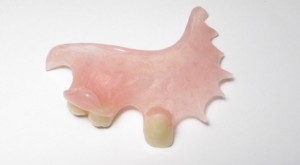For most patients missing a single tooth, a fixed (non removable) and natural looking replacement is the number one priority. Historically, dental bridges offered these results by crowning the teeth adjacent to the missing space and "bridging" it with a false tooth. However, the rise of dental implants has created new opportunities to restore missing teeth without needing to modify the neighboring dentition. The best choice for your mouth depends on a number of biological and cosmetic factors. Take a look!
Dental bridges are an excellent way to restore missing teeth without requiring surgery or implant placement. The most obvious drawback is that the adjacent teeth need to be modified to receive crowns to support the bridging tooth. However, if both teeth already have crowns or large fillings, a bridge can seem like a more attractive option. The biggest hesitation towards placing a bridge is when one of the neighboring teeth is completely healthy and free of any previous dental work. From a oral hygiene standpoint, bridging two teeth creates a potential food trap and an area that is difficult to floss. You will probably need to use floss threaders to clean under and around this area. Cosmetics are difficult to judge on bridges. The height of remaining soft tissue, space to be covered by the false tooth and angulation of adjacent teeth will all influence the final outcome.
Likewise, implants allow dentists to restore missing teeth independently of neighboring teeth. In fact, an implant does not even need a tooth on both sides of it to be placed. This is why implants are the first choice for replacement when the last teeth in the dental arch are lost. Since an implant is placed surgically, cosmetics can be managed via bone remodeling and gum grafting. A well placed implant is indistinguishable from natural teeth. However, implants have a long healing time, typically requiring 6+ months from insertion to final crown placement. In the meantime, patients are provided with a temporary denture called a flipper if cosmetics are a concern. Another consideration with implants is bone height and health. There needs to be ample space and width for the implant to be placed without damaging nerves, blood vessels or sinuses. Not every patient will qualify for implant surgery.
Deciding between an implant or a bridge is ultimately your choice. However, an exam and conversation with your dentist can alleviate concerns and help guide you towards the option that suits your needs best. If you would like to schedule an exam or consultation, please give our office a call today!










